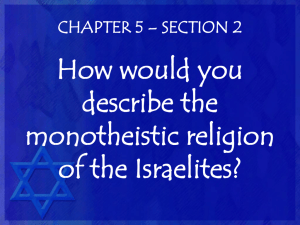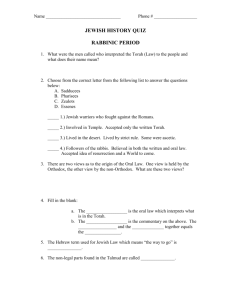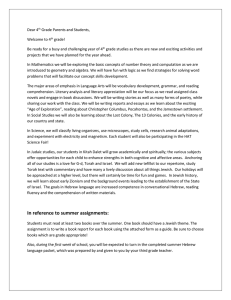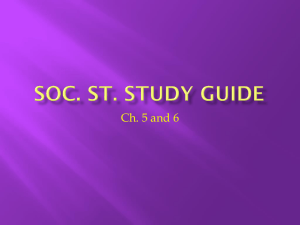File
advertisement
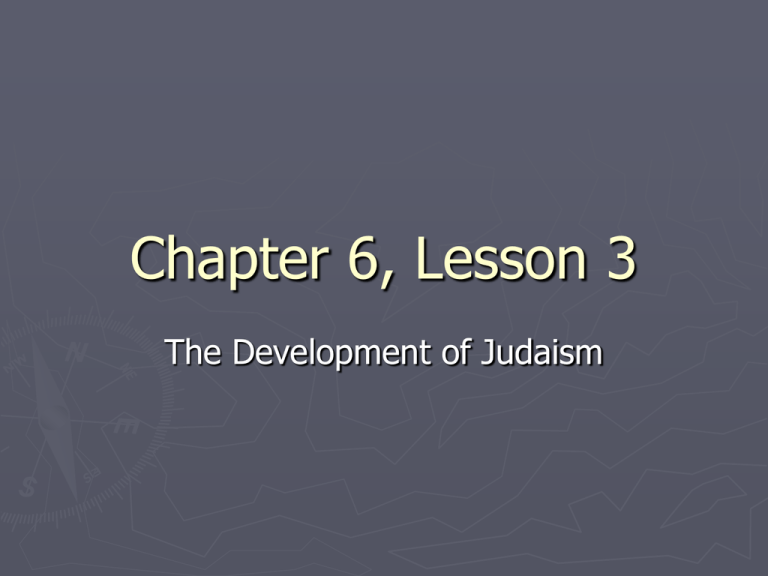
Chapter 6, Lesson 3 The Development of Judaism Return to Judah ► The families of the Judeans who were exiled to Babylon spent 70 years away from Judah. During the exile, they became known as Jews. Their religion is known as Judaism. ► While in Babylon, the Jews no longer had a temple to worship God. It is believed they instead used synagogues (Jewish houses) of worship. ► The Jews would worship on the Sabbath, which according to tradition, last from sundown Friday to nightfall Saturday. During this weekly day of worship and rest, Jews prayed and spoke of their religion and history. Rebuilding Judah ► While some Jews were ok with living in Babylon permanently, others hoped to return to Judah. It was finally achieved when the Persians swept across Southwest Asia, defeating the Chaldeans and taking over Babylon. In 538 B.C., the Persian king Cyrus II let the Jews return to Judah. ► Some would stay in Babylon but many would return to Judah and rebuild Jerusalem. They also constructed to replace the one destroyed by the Chaldeans known as the Second Temple. Rebuilding Judah ► The Persians set up officials to rule the country and collect taxes from the people. The Jews were not allowed to have their own government or king. Mostly depended on religious leaders such as temple priests and scribes to guide them. ► Many priests were religious scholars who had a deep understanding of the faith. Scribes lectured in synagogues and taught in schools. Rebuilding Judah ► Ezra, a scribe, led them in writing five books of the Torah on pieces of parchment. The pieces were sewn together to make long scrolls. ► The Torah and writing that were added later make up the Hebrew Bible. What Is In the Hebrew Bible? ► The Hebrew Bible clearly defined rules for the ancient Jews and is made up in three parts. The Torah, the Prophets, and the Writings. ► It contains a series of 24 books written and collected over many centuries. Explains the laws and rules of the Israelites. Reflects the Culture of the people through Jewish history, art, literature, poetry, and proverbs. What Is In the Hebrew Bible? Genesis, the first book of the Torah, presents the Israelite view of human beginnings. According to this, God created the Earth in six days, and rested on the seventh. ► Also explains how God punished the world for wicked behavior. In this book, God warns Noah that a flood is coming, and commands him to build an ark, or large boat. Noah, his family, and two of every animal in the world boarded the ship as the world flood. After the flood God placed a rainbow in the sky to signify a flood would never destroy the world again. ► What Is In the Hebrew Bible? ► God also explains in Genesis why people in the world speak different languages. Tells how the city of Babel tried to build a tower to reach heaven. God did not approve of this and made the people speak different languages to prevent them from completing the tower. He then scattered the people around the world. ► Later parts describe what the Jews hoped for a future. What Is In the Hebrew Bible? ► The Book of Isaiah described God’s plan for a peaceful world: “[W]ill beat their swords into plowshares and their spears into pruning hooks. Nation will not take up sword against nation, nor will they train for war anymore.” – Isaiah 2:4 ► The book of Daniel explains that evil and suffering would one day be replaced by goodness. Daniel, a Jew, was an advisor to a Babylonian King but did not worship Babylonian Gods. He was punished by being thrown into a lion’s den but God protected him serving as an example that God would save them. Christians and Muslims also share hope of a better world in which good triumphs over evil. Jewish Daily Life ► The Torah provides teachings for daily living and it shaped the family life of early Jews. It gave instruction on what foods to eat and what clothes to wear. Also dealt with helping the poor, being honest with their neighbors, and applying laws fairly. Finally, it also spoke of individual worth and responsibility, self-discipline, and served as a reminder to be loyal to God. The Jewish Family ► The Torah specifies roles for the father and mother of the house. If a father died, his sons would take his place as head of the household. ► Jewish families also stressed education, especially for young men. Once a son was old enough they learned to worship God and learned a trade. Under the guidance of religious leaders they would learn to read the Torah. (Much of all they learned was from the Torah.) Because reading the Torah was central to Jewish life, religious teachers became community leaders. The Jewish Family ► Daughters learned from their mothers to be wives, mothers, and housekeepers. It also included learning about Jewish food, the Sabbath, and holidays. ► They also learned about the ancient women of Israel such as Ruth and her mother-in-law Naomi. According to the Hebrew Bible, Naomi’s husband and her two sons died. One of the sons was married to Ruth though she was not Jewish and she made the ultimate decision of being with her Mother-in-law in Bethlehem. This showed the girls how important family was. Dietary Laws ► Jewish law tells what they can eat. They could eat beef and lamb but not pork. Laws about food were known as kashrut, which meant “that which is proper.” They believed that by following these laws they showed their obedience to God. ► Food that is prepared according to Jewish dietary laws are considered kosher. Many items you see in the store have a symbol to show if it is kosher. Animals used in kosher meat must be killed in a certain way. Dietary Laws ► The meat must be inspected, salted, and soaked in water. If the food is not kosher it is considered unclean. They are not allowed to eat meat and dairy together. They cannot eat shellfish (crabs, etc.) or shrimp. ► Some foods have religious significance. The seder (say-duhr) is a special meal eaten over Passover and is used to celebrate the Exodus of the Jews from Egypt. Dietary Laws Foods such as lamb, hardboiled eggs, vinegar, salt water, herbs, and matzoh (flatbread) are served at the seder. During the meal, the youngest child at the table asks questions about Passover. The Adults and older children at the table recite the answer to the question together. Example: Eating bitter herbs reflect the bitter experience of the Jews living in exile. The tradition of eating special foods at Passover and reflecting on history is sacred to the Jewish people.
